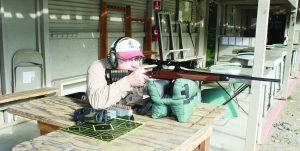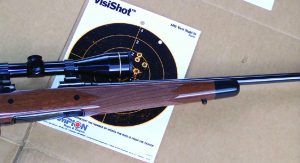by Dave Workman | Senior Editor

Author at the shooting range in preparation for the coming hunting season. He urges all prospective hunters to get on target before the hunting season actually starts.
Squeezing off a shot at some nice buck at 150 yards is the wrong time to be finding out your hunting rifle isn’t properly zeroed.
Right now, when deer and elk seasons are still weeks away is the time to be visiting the range to make sure your rifle is properly sighted in. In the east, that might be as simple as hitting dead-on at a 100 yards, or perhaps a couple of inches high at 100 so you’re in the bull’s eye at 200 yards.
Out west, where shots might be as long as 300-400 yards, it takes a little bit more homework and patience. One should know his own limitations as a marksman and the limitations of the rifle and its caliber.
Whether I’m hunting with my .257 Roberts, .300 Savage, .308 Winchester or .30-06 Springfield, I’m always careful to hit the range well in advance of the season to make sure the windage and elevation settings on my scopes are dialed in properly. This is imperative whether one uses factory ammunition or loads his/her own at home. The ultimate goal is the same, a notched tag and meat in the freezer.
If you’re zeroing in for the first time with a new rifle and/or scope, to get a rough scope setting one should initially place a target at 25 yards. After making sure your scope mounts are tight, fire a single shot at a clean target with a clean backing and study that to see how far off zero the bullet strikes. Then just to make sure you didn’t flub with a flinch, fire a second shot. If the rounds strike together, let the rifle cool off while you adjust.
Let’s say at 25 yards, your bullets strike three inches low and two inches right. If you’re using a scope that adjusts a quarter-inch at 100 yards for each click of your windage and elevation settings, remember you will have to multiply by four the number of clicks you apply to bring the bullet impact into the bull’s eye; one click at 100 translates to four clicks at 25 yards. In this case, that would be at least a dozen clicks up and eight clicks left.
Fire a third shot. If the bullet strikes in the X-ring but is still slightly low or high, left or right of center, adjust accordingly. A fourth shot should have you roughly dialed in enough to fire at a 100-yard target after the rifle barrel is allowed to cool.
 Why wait? Because a hot barrel can be tough to zero, and because out in the woods, you’ll be firing that first and, hopefully, only shot through a cold barrel. It’s also possible to dramatically shorten barrel life by repeatedly shooting until the barrel is so hot you can’t touch it.
Why wait? Because a hot barrel can be tough to zero, and because out in the woods, you’ll be firing that first and, hopefully, only shot through a cold barrel. It’s also possible to dramatically shorten barrel life by repeatedly shooting until the barrel is so hot you can’t touch it.
When the barrel has cooled, expect your first shot at 100 yards to be off slightly. Then adjust accordingly, one click for each quarter-inch you need to move the impact point, or four clicks to move your bullet an inch right, left up or down.
Windage is the important factor here. Make sure you’re not shooting right or left. Once you’ve got that problem licked, then it’s time to figure for longer shots, and that’s pretty simple. If one sights his rifle to shoot two to 2½ inches high at 100 yards, that bullet is generally going to be spot on at 200-225 yards. Because I hunt in the west and have been shooting deer over the past few years at 200-350 yards, I bump that up to shoot 3-4 inches high at 100 yards because trajectory begins to suffer at longer ranges, even with the flattest-shooting bullets and calibers.
Recently at the range, my ’06 was putting bullets at 4 inches above the X-ring at 100 yards. That’s the rifle I whacked a mule deer buck with four years ago at 350 yards, one shot across a canyon. The scope hadn’t been touched and it was still set right where I want it.
Three years ago I was in the same canyon and nailed a big 4×5-point (western count) buck with my bolt-action Savage in .308 at 209 yards. That rifle puts my rounds at 2½-3 inches high at 100.
One should always sight in using a good solid rest, whether a block of wood or sandbag. In the field, try to use as good a rest as you can, whether a backpack, stump, boulder or whatever is available. I have only killed a couple of deer when I wasn’t using a rest, and one of those was taken with a handgun.
Always zero a rifle with the same ammunition you’re using in the field. Sighting in a rifle using, say, ammunition with 150-grain bullets doesn’t make much sense if you’re going to be hunting with cartridges topped with 180-grainers.
If you’re not into reloading, save your empty brass anyway. Chances are, you know somebody who does, and good once-fired brass is not easy to come by.
After your range visit, clean your rifle thoroughly. Add a couple of drops of gun oil to the action, run an oiled patch down the barrel followed by a dry one. Make sure to apply oil to the underside of your barrel.



